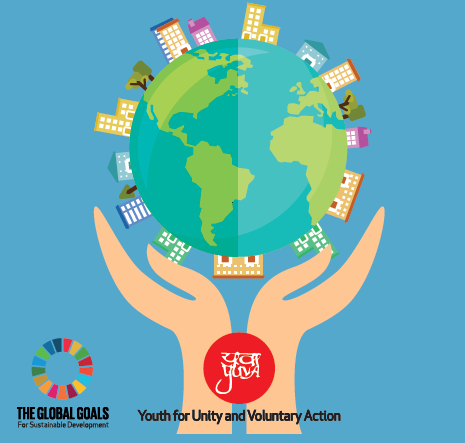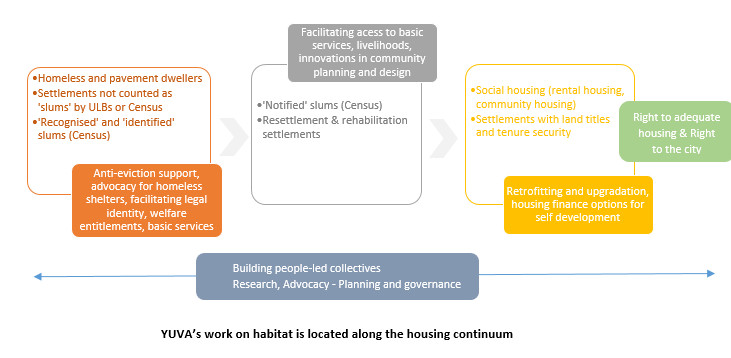
The Question of Habitat
The term habitat refers to much more than housing — while housing directly relates to one’s dwelling structure, habitat includes access to adequate housing, basic services, open spaces, education and health amenities, safe environments and so on. Habitat links the development of human settlements and cities to the realisation of human rights.
Growing inequality and the financialisation of housing have underlined again the need to refocus our attention for a ‘seismic shift’ in urban habitat. Our work on the habitat thematic attempts to address emergent challenges. But first, a note on the multifarious experiences related to habitat in the city.
One Word, Many Experiences
In Indian cities one sees stark differences in the experience of habitat — almost always, this is linked to socio-economic differences. Poverty, too, is experienced in different ways, based on one’s location and capabilities. This, in turn, influences the experience of habitat. The housing continuum is a concept that explains the various housing options available with varying levels of security of tenure and resultant habitats (see Figure 1). For YUVA, it outlines the movement of the urban poor who migrate to cities and their search for shelter, and informs our interventions at various levels.

At the extreme end of the continuum are the homeless who have no security, no access to basic services and live a precarious existence. Then there are those living in small settlements (with less than 60 households) who lack basic services like water, sanitation and are unrecognised by the urban local body. Next are ‘identified’ slums that are defined as, ‘A compact area of at least 300 population or about 60–70 households of poorly built congested tenements, in unhygienic environment usually with inadequate infrastructure and lacking in proper sanitary and drinking water facilities’. A step ahead is what the Census calls ‘recognised’ settlements, recognised as ‘slums’ by the state authorities or local governments, which may have not been formally notified as slum under any law. These settlements are vulnerable to forced evictions. This is the far end of the continuum where housing insecurity is high.
Following this are slums recognised by laws in a particular state. The Census defines them as ‘notified areas in a town or city notified as “Slum’’ by State, Union Territory Administration, or Local Government under any Act including a Slum Act’. In such settlements, tenure security varies across cities, however they are legally entitled to basic services and should be provided alternate housing in case of involuntary displacement. Resettlement and rehabilitation (R&R) housing is an option provide by the State as a means of public housing in case of involuntary displacement. Slums that choose to voluntarily resettle have similar security of tenure in many cities.
At the other end of the continuum is housing where tenure security has been provided by the state and technically they should be de-recognised as slums itself. Also at this end are state-provided housing options such as rental housing, where the State recognises migration into cities and adequately provides for housing for the population.
Our Approach
YUVA’s work on concerns surrounding habitat is rooted in a rights-based framework, located along the housing continuum. It is crucial for us to work across the continuum to address inequalities and complexities of land and housing issues in different contexts across urban India. Settlements across the country are inhabited by people of varying socio-economic capacities. Our work responds to their multi-faceted needs, while also taking into account city-level and state-level land legislations with a clear vision to mitigate urban inequalities.
Working on Habitat Questions
YUVA’s work across cities, uses the housing continuum as a pathway to respond to separate urban contexts. Based on the needs of local communities we take forward associated interventions to empower people. For instance, we may have started working with a homeless community in the city of Mumbai who are now resettled. As a result, interventions and support have adapted to suit their needs. From advocating for the prevention of forced evictions in various cities to securing land tenure rights in Nagpur to unpacking tenability and viability of resettlement housing in Indore, our work on habitat spans across a wide spectrum. Currently, our work spreads across five states and seven cities — Mumbai, Navi Mumbai, Nagpur (Maharashtra), Indore (Madhya Pradesh), Bhubaneswar (Odisha) Guwahati (Assam) and Delhi. Key elements of our work include:
- Extensive engagement with communities
- Capacitating community leaders and people’s organisations
- Enabling people’s participation in local governance through provisions mandated under the 74th Constitutional Amendment Act
- Enabling access to legal documents, welfare entitlements
- Facilitating access to basic services such as water, sanitation, etc
- Awareness and capacity building on urban planning, municipal budgets, and housing so that communities are empowered to make their own decisions
- Critical engagement in land use planning processes
- In the cities of Nagpur, Indore and Bhubaneswar we engaged extensively with advocacy for land tenure security
- Research on various issues impacting Indian cities
- Advocacy at the local, state and national level on framing inclusive urban policies
#UrbanOctober2018
This month, alongside our engagements on habitat we will also be talking about the theme for this year, municipal solid waste management through a month long campaign #गन्दीबात #TrashTalk. We will be joining our voices with the global network of organisations to discuss how we can address concerns in waste management in cities. To know more about what we are doing, do stay tuned for our blog and social media updates.
विश्व पर्यावास दिवस पर युवा द्वारा किये गए कार्यों की एक झलक
पर्यावास के बुनियादी सवाल
जब हम घर की बात करते हैं तो हमारे मन में चार दीवारों से घिरे ए़क ढांचें की तस्वीर उभरती है. यह ए़क येसा ढांचा होता है जिसमें लोग रहते हैं. लेकिन पर्यावास का मसला महज चार दीवारों तक ही सीमित नहीं है. पर्यावास लोगों के रहने के लिए उनकी मूलभूत आवश्यकताओं से युक्त होना चाहिए. जैसे पीने के लिए स्वच्छ जल, बच्चों के लिए स्कूल, खेलने के लिए मैदान साथ ही भय रहित समाज. पर्यावास का शहर के विकास से सीधा संबंध है इसलिए हमें इस मुद्दे पर गंभीरता से विचार करने की जरूरत है.
शहरों में असमानता का स्तर तेजी से बढ़ रहा है. साथ ही कुछ लोगों के लिए घर रहने की जरूरत न होकर अब आर्थिक मसला बन गया है. येसे में पर्यावास को लेकर नए सिरे से सोचने की गंभीर जरूरत है.
हम मुंबई शहर में पर्यावास के इन्हीं अनुभवों को साझा करेंगे.
एक शब्द, हजार अनुभव
भारतीय शहरों में पर्यावास लोगों के सामाजिक और आर्थिक असमानता से जुड़ा होता है. इसलिए इन जगहों पर पर्यावास के मामले में लोगों के अनुभव भी अलग-अलग होते हैं. शहरों में हर व्यक्ति के लिए गरीबी का स्तर अलग होता है. कई बार इसका आकलन व्यक्ति के रहने की जगहों और उनकी क्षमता के आधार पर किया जाता है.
आवास निरंतरता ए़क नजरिया है जो हमें आवास के संदर्भ में तरह-तरह के उतार चढावों से रूबरू करता है. जैसे आवास की सुरक्षा तथा इसका पट्टा. युवा शहरों में रोजगार की तलाश में पलायन कर आये हुए गरीबों को रहने के लिए सस्ता आवास मुहैया कराने तथा उनके अधिकारों के लिए निरंतर संघर्षरत है. शहरों में आज भी बहुत से लोग बेघर हैं जिनको न तो पर्याप्त सुरक्षा मिल पाती है और न ही उनके मूलभूत अधिकार. येसे भी कई परिवार होते हैं जो अस्थायी रूप से छोटे-छोटे घरों में रहते हैं. स्थानीय प्रशासन द्वारा इन्हें ‘चिन्हित् बस्ती’ कहा जाता है. इस तरह की बस्तियों में कम से कम 60 घर और 300 की आबादी होना जरूरी है. ज्यादातर येसी बस्तियो में मूलभूत सुविधाओं का अभाव होता है. यहां न तो सफाई की व्यवस्था होती है और न ही पीने के लिए स्वच्छ पानी. यही वजह है कि बस्तियों में रहने वाले अधिकतर लोग गंभीर बीमारियों की चपेट में आ जाते हैं.
भारतीय जनग़णना आंकड़ों के अनुसार अधिकृत अधिवास की मान्यता राज्य सरकार तथा स्थानीय प्रशासन द्वारा दी जाती है. इसके अंतर्गत बस्ती यानी स्लम वह है जो किसी भी कानून द्वारा अधिसूचित नहीं किया गया हो. इन अधिवासों के हमेशा प्रशासन द्वारा तोडने का खतरा बना रहता है.
जनग़णना द्वारा येसे अधिवासों को तब बस्ती अथवा ‘स्लम’ तभी कहा जाता है जब ये राज्य सरकार या केंद्र शासित प्रशासन द्वारा ‘स्लम एक्ट’ के अंतर्गत अधिसूचित की गई हों. इसके बावजूद भी इन बस्तियों में रहने वालों के पास पट्टा या अपने घरों को बचाने के लिए कोई भी अधिकार नहीं होता है. कई बार शहरों में विकास के नाम पर बस्तियों को ढहा दिया जाता है. और यहां रहने वाले लोगों को उनकी इच्छा के खिलाफ पुनर्वास कालोनियों में रहने भेज दिया जाता है.
युवा का सुझाव
युवा अपने आसपास पर्यावास से संबंधित मसलों पर विभिन्न कार्य कर रहा है. उसका मानना है कि पर्यावास को ए़क उचित संरचना के अंतर्गत देखने की आवश्यकता है. भारत के अधिकतर शहरों में परिस्थितियां ए़क सामान नहीं होती हैं. ज्यादातर शहरों में जमीन और घर जैसे मूलभूत मुद्दे पर काम करना कठिन है. देश में अब भी घर लोगों की सामाजिक-आर्थिक क्षमता को दर्शाता है. ‘युवा’ मुख्य रूप से शहरों में लोगों के बीच आर्थिक असमानता को कम करने की दिशा में अनेक प्रयास कर रहा है. आर्थिक असमानता को दूर करने के लिए देश में शहर तथा राज्य स्तर पर जमीन से संबंधित स्पष्ट कानून बनाने की जरूरत है.
पर्यावास के मसले पर विभिन्न कार्य
युवा शहरों में पर्यावास के साथ ही लोगों को उनके मूलभूत आवश्यकताओं के प्रति जागरूकता फैलाने का महत्तवपूर्ण कार्य करता है. इसके प्रयासों के चलते मुंबई में कई बेघरों को स्थानीय प्रशासन ने घर मुहैया कराया. इसमें शहरों में जबरन निष्कासन की रोकथाम के लिए वकालत करना तथा इन मुद्दों से स्थानीय वंचित लोगों को जोड़कर उनके अधिकारों के लिए प्रयास करना जैसे अनेक कार्य शामिल है. नागपुर में लोगों को जमीन का पट्टा दिलाने की दिशा में कई प्रयास किये गए. वर्तमान में युवा भारत के पांच राज्यों तथा सात अलग-अलग शहरों में अनेक कार्य कर रहा है. इनमें मुंबई, नवी मुंबई, नागपुर(महाराष्ट्र), इंदौर(मध्य प्रदेश), भुवनेश्वर(उडीसा),गुवाहाटी(असम),और दिल्ली.
युवा द्वारा पर्यावास तथा घर के मुद्दे पर शहरों में किये गए अन्य प्रमुख कार्य:
- समुदाय में लोगों तक व्यापक पहुंच और उनके बीच ए़कजुटता स्थापित करना
- समुदाय के सदस्यों, उनके प्रमुखों तथा संस्थाओं में नेतृत्व क्षमता विकसित करना
- 74 संविधान संशोधन के अंतर्गत स्थानीय शासन में लोगों की पहुंच सुनिश्चित करने हेतु प्रयास करना
- वंचित लोगों तक सरकारी कल्याणकारी योजनाओं की पहुंच स्थापित करना
- लोगों तक पानी तथा स्वच्छता जैसे मूलभूत सुविधाओं तक पहुंच सुनिश्चित करना
- लोगों में शहरी नियोजन, महानगर पालिका बजट और घर जैसे मुद्दों के प्रति जागरूक करना. किसी भी सरकारी आदेश तथा योजना के प्रति लोगों को स्वंय उचित निर्णय लेने के योग्य बनाना
- शहरी नियोजन तथा जमीन का उपयोग करने के मसले पर लोगों की भागीदारी के लिए प्रयास
- नागपुर, इंदौर तथा भुवनेश्वर में जमीन का पट्टा मिलने तथा इसकी सुरक्षा हेतु लोगों को ए़कजूट करना
- शहरों को प्रभावित करने वाले कारणों की पहचान करने हेतु शोध करना
- शहरों में योजनाओ के निर्धारण तथा समावेशी विकास के लिए स्थानीय, राज्य और केंद्र स्तर पर प्रयास करना
#UrbanOctober2018
इस महीने हम पर्यावास के साथ-साथ शहरों में ठोस कचरा प्रबंधन के लिए #गन्दीबात अभियान के जरिए लोगों को जागरूक करने का प्रयास करेंगे. इस दौरान हम वैश्विक स्तर की संस्थाओं के साथ शहरों में कचरा प्रबंधन की समस्या को सुलझाने के लिए आपसी बातचीत करेंगे.
इस बारे में अधिक जानकारी के लिए आप हमसे हमारे ब्लॉग और अन्य सोशल मिडिया प्लेटफार्म से जुड सकते हैं.
Translated to Hindi by Sushil Kumar


